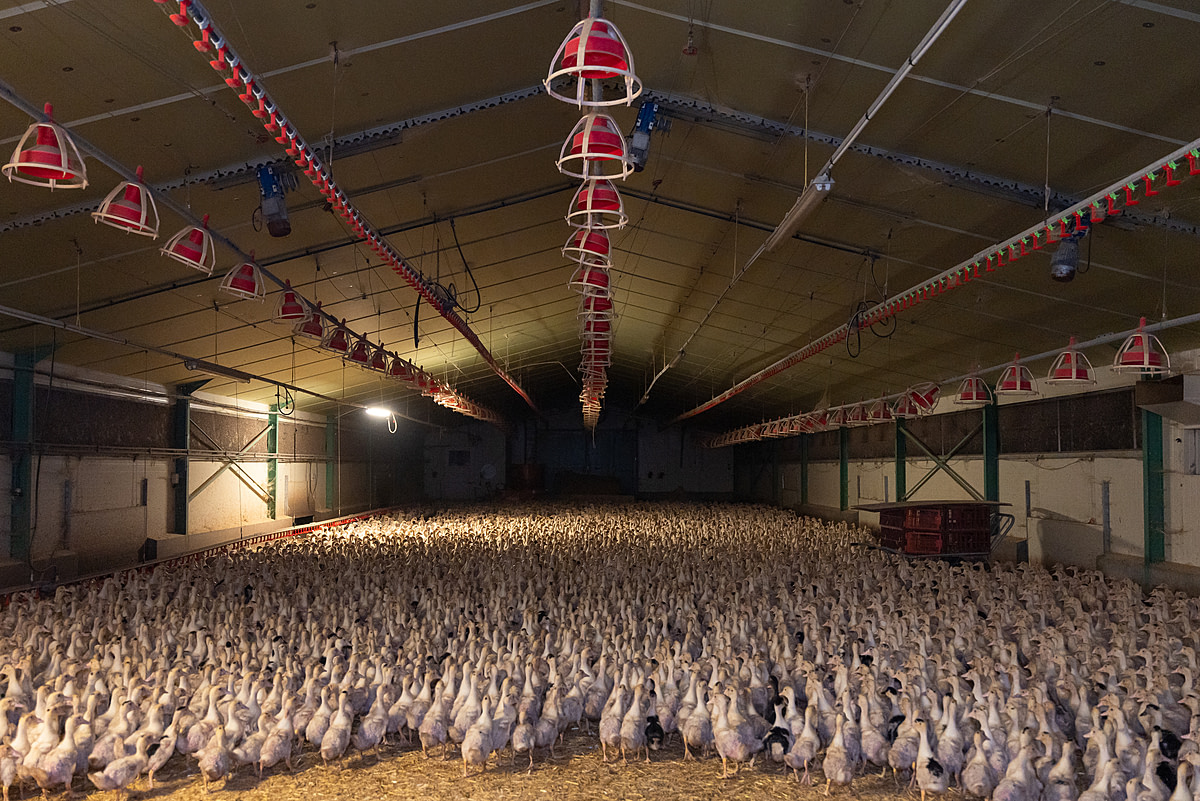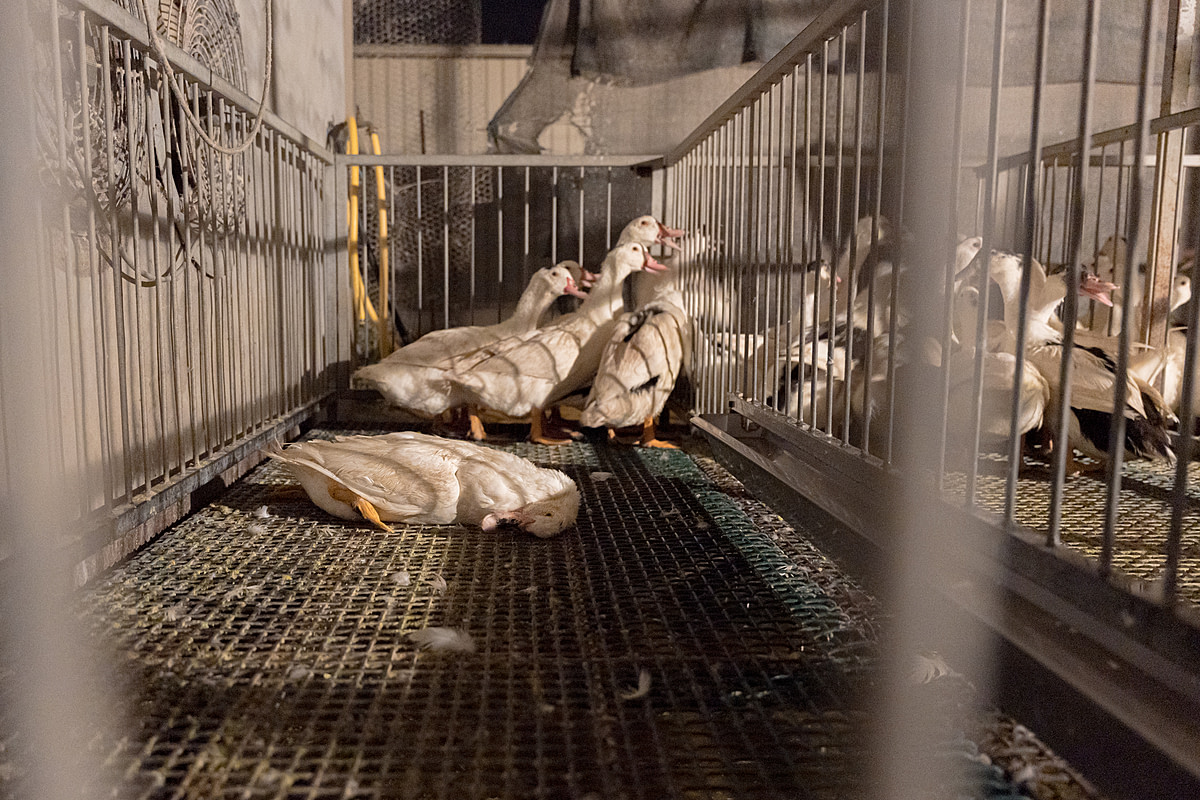Inside the Foie Gras Industry
Photographer: Pierre Parcoeur
Author: We Animals Media
Explore and download these visuals via our stock platform.
Foie gras production remains contentious around the globe and its methods have long raised ethical concerns. We Animals Media photojournalist Pierre Parcoeur recently visited foie gras farms in southwestern France to document the experience of birds living inside these spaces.
“This highly controversial issue divides the French public opinion. Indeed, foie gras is generally the first dish individuals stop eating as soon as they become aware of the cruel farming conditions. Through my work, I was eager to show this “French tradition” from a different angle, namely one that puts animals back at the centre of the debate to raise awareness and make animal suffering more visible and understandable by society.” ― Pierre Parcoeur, animal photojournalist
In 2020, an estimated 119,000 geese and 26.9 million ducks were force-fed and slaughtered in France for foie gras, which accounts for approximately 70% of the industry’s EU production and two thirds of world production.
Curious young ducklings raised for foie gras production stare into the camera. Undisclosed location, Sort-en-Chalosse, France, 2023. Pierre Parcoeur / We Animals Media
WHAT IS FOIE GRAS?
Foie gras (French for ‘fatty liver’) is a speciality food product made from the liver of a duck or goose. To produce foie gras, birds are force-fed to fatten their livers up to 10 times their natural size through a process traditionally referred to as “gavage”. Considered an ambassador of French cuisine, foie gras has been officially recognized as part of “protected cultural and gastronomic heritage in France” since 2006, despite 60% of French citizens being against the industry’s traditional practices in more recent years.
During this assignment, our photojournalist witnessed tens of thousands of ducks packed together inside dark and overcrowded rearing barns. These ducks spend the early part of their lives inside these barns before they are mature enough to be used in foie gras production.
Countless ducklings raised for foie gras production live on the floor of a crowded, massive barn. Undisclosed location, Louer, France, 2023. Pierre Parcoeur / We Animals Media
A dead duckling raised for foie gras production lies face-up on a dusty cardboard box inside a rearing barn. Undisclosed location, Sort-en-Chalosse, France, 2023. Pierre Parcoeur / We Animals Media
“Taking up this assignment was a challenging experience due to the health issues linked to the bird flu epidemic in France as well as the strong desire of farmers to hide practices. Although I couldn’t take pictures of animals being force-fed, I did observe mistreatment including the high concentration of farmed animals confined on urine-soaked floors and raised in pens surrounded by rotting corpses. The two-week force-feeding of ducks and geese is pure suffering since the production purposefully induces hepatic steatosis, also referred to as fatty liver disease.” ― Pierre Parcoeur
The force-feeding process involves ramming a long pipe into a bird’s oesophagus three times per day. A mix of corn and fat is fed through this pipe into the bird’s liver, resulting in rapid weight gain. It’s not uncommon to see birds panting and collapsing inside farms, unable to support the pressure and weight this places on their unconditioned bodies.
These poignant images from photojournalist Luis Tato and featured in our book HIDDEN, show the stark reality for birds being force-fed inside foie gras farms.
Foie Gras Bans
While force-feeding ducks and geese has already been prohibited in 22 EU Member states, it remains legal in France, Hungary, Spain, Bulgaria, and one region of Belgium, despite citizens across the EU calling for its end due to animal welfare concerns.
Zooming out to look at the global foie gras industry, more and more jurisdictions are taking a stand for higher animal welfare standards and placing bans on foie gras import and/or production. For example, in May 2022 California’s Supreme Court upheld its ban on foie gras despite Canadian duck and geese farmers challenging the state. New York City has also sought to ban foie gras production, despite ongoing backlash from the State. Closer to home however, we’re seeing the Canadian province of Quebec fighting to hold on to this aspect of its French heritage, with the federal government propping the industry up through subsidies.
What Can I Do To Help?
Change and progress is on the horizon with various innovators disrupting the industry with animal-free foie gras alternatives, which include high-quality, flavoursome and cruelty-free products from independent companies such as Hello Plant Foods and The Better Meat Co. and even large corporate companies such as Nestlé. We can all be a part of the solution by choosing plant based alternatives to animal products.
Hello Plant Foods in Spain, for example, began selling vegan FUAH in 2022 and sold out within 12 hours of its product launch after receiving exceptional demand. Javier Fernández, Founder of Hello Plant Foods, said in conversation with The Guardian: “…The only way that change happens is when the product is excellent and very similar to what people are going to give up. We’ve solved that.”
Teresa Gangnier, Humane Educator at SAFE, hugs Delilah. Delilah and her sister Daphne were rescued from a foie gras farm. Quebec, Canada, 2022. Jo-Anne McArthur / We Animals Media
In addition to the availability and accessibility of plant-based versions of foie gras, the historical and ongoing efforts of animal advocates continue to inform the public about the issues associated with foie gras production and place pressure on governments to do better for animals caught up in this cruel industry. We can raise awareness in our communities too by sharing these important stories and visuals.
We can recognize and celebrate our cultures and heritages without inflicting unnecessary cruelty and suffering on other animals. Foie gras can and should be a thing of the past.
Data sources: Statista / Statista / Statista / L214 / Four Paws / Eurogroup for Animals / CNN / The Guardian / Animal Justice / Vegconomist / The Guardian
Images by Pierre Parcoeur
Explore and download visuals from this assignment via our stock platform, which offers 20,000+ images and video clips for free to anyone helping animals.
Donate today and help us continue to produce compelling global investigations into these cruel industries.
More like this from We Animals Media:
Stock Photos & Video: The Future Of Food
by We Animals Media | Jan 24, 2022
Investigation: Duck Egg Farming – Indonesia, 2021
by We Animals Media | Dec 22, 2021
















